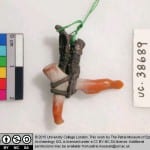Research engager goes abroad
By rmjllil, on 7 September 2015
By Ann Liljas
Our research engager Ann has explored exhibitions about ancient Egypt in Rome and Dublin.
In the last few months I have been to Rome and Dublin. In Rome I visited the Vatican Museums which consists of several museums of which one is about ancient Egypt. In Dublin I spent a couple of hours at the National Museum of Ireland where visitors are introduced to ancient Egypt. In this blog post I present a couple of items on display at these two exhibitions. If you want to find out more, visit Petrie museum in London part of your preparations for your trip to Rome or Dublin.
One of the first things you get to explore when entering the Vatican Museums is the museum about ancient Egypt. It was founded by Pope Gregory XVI in 1839 and has several interesting  artefacts for those interested in the complex civilisation of ancient Egypt. Highlights include statues, papyruses, animal mummies and reproductions of the Book of the Dead. During my visit I took a closer look at the collection of small statues called Shabtis. The word Shabti refers to “respond” or “answer” and these statues of adult male or female form were supposed to carry out tasks on behalf of a person in the afterlife such as heavy manual work. The Shabti figures on display vary in size and some are made of stone and others of wood. A sign next to them tells the visitor that they were wrapped in bandages like mummies and the number of shabtis in a burial could be as many as one for every day of the year. The use of shabtis increased over time but during the Ptolemaic Period the use of these statues gradually disappeared. Now, the good news is that you do not have to go all the way to Rome to see Shabtis as there are several of them on display at the Petrie museum in London.
artefacts for those interested in the complex civilisation of ancient Egypt. Highlights include statues, papyruses, animal mummies and reproductions of the Book of the Dead. During my visit I took a closer look at the collection of small statues called Shabtis. The word Shabti refers to “respond” or “answer” and these statues of adult male or female form were supposed to carry out tasks on behalf of a person in the afterlife such as heavy manual work. The Shabti figures on display vary in size and some are made of stone and others of wood. A sign next to them tells the visitor that they were wrapped in bandages like mummies and the number of shabtis in a burial could be as many as one for every day of the year. The use of shabtis increased over time but during the Ptolemaic Period the use of these statues gradually disappeared. Now, the good news is that you do not have to go all the way to Rome to see Shabtis as there are several of them on display at the Petrie museum in London.
The exhibition at the National Museum of Ireland includes four mummies, jewellery and other personal adornments portraying life and death in ancient Egypt. The collection consists  of artefacts from several excavations throughout the Valley and Delta led by Flinders Petrie. I really liked a painted wooden model of a Nile boat with rowers and armed guard from c.1900 BC. The model was found in a tomb and boat models of different types were often included in Middle Kingdom tomb equipment. Boats were important as they were the swiftest and most reliable mode of transport and communication. In contrast to many other models found this one includes an armed man with speckled cowhide shield. An informative sign next to the model suggests it may be that he is the officer and the crew a troop of soldiers. Military features in burials around this time may reflect the civil wars of the First Intermediate Period which ended c. 2025 BC.
of artefacts from several excavations throughout the Valley and Delta led by Flinders Petrie. I really liked a painted wooden model of a Nile boat with rowers and armed guard from c.1900 BC. The model was found in a tomb and boat models of different types were often included in Middle Kingdom tomb equipment. Boats were important as they were the swiftest and most reliable mode of transport and communication. In contrast to many other models found this one includes an armed man with speckled cowhide shield. An informative sign next to the model suggests it may be that he is the officer and the crew a troop of soldiers. Military features in burials around this time may reflect the civil wars of the First Intermediate Period which ended c. 2025 BC.
Have you been to any of these exhibitions or any other exhibition about ancient Egypt outside the UK? Share your experience with me and the other research engagers next time you visit Petrie museum. Research engagers are PhD students at UCL who regularly spend time at the museums speaking to visitors about their research. We are also interested in hearing your thoughts on the  collections as well as research at UCL. And we love when visitors ask us questions! Although we may not be experts on ancient Egypt as our field of study ranges from mechanical engineering to epidemiology, we will try our best to answer your questions. Questions that we think are interesting to share with others may be published here on our website. We look forward to speaking to you at your next visit.
collections as well as research at UCL. And we love when visitors ask us questions! Although we may not be experts on ancient Egypt as our field of study ranges from mechanical engineering to epidemiology, we will try our best to answer your questions. Questions that we think are interesting to share with others may be published here on our website. We look forward to speaking to you at your next visit.
 Close
Close














